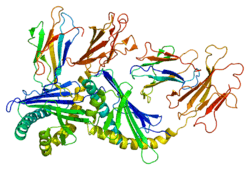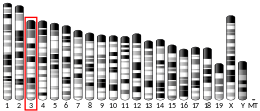CD1D
CD1D is the human gene that encodes the protein CD1d,[5] a member of the CD1 (cluster of differentiation 1) family of glycoproteins expressed on the surface of various human antigen-presenting cells. They are non-classical MHC proteins, related to the class I MHC proteins, and are involved in the presentation of lipid antigens to T cells. CD1d is the only member of the group 2 CD1 molecules.
Biological significance
CD1d-presented lipid antigens activate a special class of T cells, known as natural killer T (NKT) cells, through the interaction with the T-cell receptor present on NKT membranes.[5] When activated, NKT cells rapidly produce Th1 and Th2 cytokines, typically represented by interferon-gamma and interleukin 4 production.
Nomenclature
CD1d is also known as R3G1
Ligands
Some of the known ligands for CD1d are:
- α-galactosylceramide (α-GalCer), a compound originally derived from the marine sponge Agelas mauritanius[6] with no physiological role but great research utility.
- α-glucuronyl- and α-galacturonyl- ceramides, a family of compounds of microbial origin which can be found, for example, on the cell wall of Sphingomonas, a ubiquitous Gram-negative bacterium.[7] The related β-D-glucopyranosylceramide is accumulated in antigen-presenting cells after infection, where it serves to activate invariant NKTs (iNKTs), a special kind of NKT.
- iGb3, a self antigen which has been implied in iNKT selection.[8]
- HS44, a synthetic amino cyclitolic ceramide analogue which has less contact with the TCR, activating iNKTs in a more constrained way than α-GalCer (specially in relation to Th2 cytokines production) and thus being more interesting for therapeutic use.[9]
CD1d tetramers
CD1d tetramers are protein constructs composed of four CD1d molecules joined together and usually fluorescently labelled, used to identify NKT cells or other CD1d-reactive cells. In particular, type I NKT cells and some type II NKT cells are stained by them. A differentiation of these two types can be obtained in human by using an antibody against the TCR Vα24 chain, which is specific of type I NKT cells.[10]
Although they are the most widely used of CD1d oligomers, sometimes CD1d dimers (two units) or pentamers (five units) are used instead.[10]
References
- GRCh38: Ensembl release 89: ENSG00000158473 - Ensembl, May 2017
- GRCm38: Ensembl release 89: ENSMUSG00000028076 - Ensembl, May 2017
- "Human PubMed Reference:". National Center for Biotechnology Information, U.S. National Library of Medicine.
- "Mouse PubMed Reference:". National Center for Biotechnology Information, U.S. National Library of Medicine.
- "P15813 (CD1D_HUMAN)". Uniprot. Retrieved 1 March 2013.
- Franck, Richard W. (1 January 2012). "C-Galactosylceramide: Synthesis and Immunology". Comptes Rendus Chimie. 15 (1): 46–56. doi:10.1016/j.crci.2011.05.006. PMC 3293403. PMID 22408579.
- Bendelac, A; Savage PB; Teyton I (2007). "The Biology of NKT Cells". Annual Review of Immunology. 25 (1): 297–336. doi:10.1146/annurev.immunol.25.022106.141711. PMID 17150027.
- Zhou, D (August 2006). "The immunological function of iGb3". Current Protein & Peptide Science. 7 (4): 325–333. doi:10.2174/138920306778018007. PMID 16918447.
- J. Kerzerho; E. Yu; C. M. Barra; E. Alari-Pahissa; E. Girardi; Y. Harrak; P. Lauzurica; A. Llebaria; D. Zajonc; O. Akbari; A. R. Castaño (2012). "Structural and functional characterization of a novel non-glycosidic iNKT agonist with immunomodulatory properties". Journal of Immunology. 188 (5): 2254–2265. doi:10.4049/jimmunol.1103049. PMC 3288653. PMID 22301545.
- Terabe, Masaki; Berzofsky, Jay A. (2008). "The Role of NKT Cells in Tumor Immunity". Adv Cancer Res. 101: 277–348. doi:10.1016/S0065-230X(08)00408-9. PMC 2693255. PMID 19055947.
Further reading
- Melián A, Beckman EM, Porcelli SA, Brenner MB (1996). "Antigen presentation by CD1 and MHC-encoded class I-like molecules". Curr. Opin. Immunol. 8 (1): 82–88. doi:10.1016/S0952-7915(96)80109-9. PMID 8729450.
- Joyce S (2001). "CD1d and natural T cells: how their properties jump-start the immune system". Cell. Mol. Life Sci. 58 (3): 442–469. doi:10.1007/PL00000869. PMID 11315191.
- Sköld M, Behar SM (2003). "Role of CD1d-Restricted NKT Cells in Microbial Immunity". Infect. Immun. 71 (10): 5447–5455. doi:10.1128/IAI.71.10.5447-5455.2003. PMC 201095. PMID 14500461.
- Brigl M, Brenner MB (2004). "CD1: antigen presentation and T cell function". Annu. Rev. Immunol. 22 (1): 817–890. doi:10.1146/annurev.immunol.22.012703.104608. PMID 15032598.
- Stove V, Verhasselt B (2006). "Modelling thymic HIV-1 Nef effects". Curr. HIV Res. 4 (1): 57–64. doi:10.2174/157016206775197583. PMID 16454711.
- Brutkiewicz RR (2006). "CD1d ligands: the good, the bad, and the ugly". J. Immunol. 177 (2): 769–775. doi:10.4049/jimmunol.177.2.769. PMID 16818729.
- Blumberg RS, Terhorst C, Bleicher P, et al. (1991). "Expression of a nonpolymorphic MHC class I-like molecule, CD1D, by human intestinal epithelial cells". J. Immunol. 147 (8): 2518–2524. PMID 1717564.
- Balk SP, Bleicher PA, Terhorst C (1989). "Isolation and characterization of a cDNA and gene coding for a fourth CD1 molecule". Proc. Natl. Acad. Sci. U.S.A. 86 (1): 252–256. Bibcode:1989PNAS...86..252B. doi:10.1073/pnas.86.1.252. PMC 286442. PMID 2463622.
- Calabi F, Jarvis JM, Martin L, Milstein C (1989). "Two classes of CD1 genes". Eur. J. Immunol. 19 (2): 285–292. doi:10.1002/eji.1830190211. PMID 2467814.
- Yu CY, Milstein C (1990). "A physical map linking the five CD1 human thymocyte differentiation antigen genes". EMBO J. 8 (12): 3727–3732. doi:10.1002/j.1460-2075.1989.tb08548.x. PMC 402056. PMID 2583117.
- Martin LH, Calabi F, Milstein C (1987). "Isolation of CD1 genes: a family of major histocompatibility complex-related differentiation antigens". Proc. Natl. Acad. Sci. U.S.A. 83 (23): 9154–9158. doi:10.1073/pnas.83.23.9154. PMC 387093. PMID 3097645.
- Balk SP, Burke S, Polischuk JE, et al. (1994). "Beta 2-microglobulin-independent MHC class Ib molecule expressed by human intestinal epithelium". Science. 265 (5169): 259–262. doi:10.1126/science.7517575. PMID 7517575.
- Maruyama K, Sugano S (1994). "Oligo-capping: a simple method to replace the cap structure of eukaryotic mRNAs with oligoribonucleotides". Gene. 138 (1–2): 171–174. doi:10.1016/0378-1119(94)90802-8. PMID 8125298.
- Suzuki Y, Yoshitomo-Nakagawa K, Maruyama K, et al. (1997). "Construction and characterization of a full length-enriched and a 5'-end-enriched cDNA library". Gene. 200 (1–2): 149–156. doi:10.1016/S0378-1119(97)00411-3. PMID 9373149.
- Kawano T, Cui J, Koezuka Y, et al. (1997). "CD1d-restricted and TCR-mediated activation of valpha14 NKT cells by glycosylceramides". Science. 278 (5343): 1626–1629. Bibcode:1997Sci...278.1626K. doi:10.1126/science.278.5343.1626. PMID 9374463.
- Katabami S, Matsuura A, Chen HZ, et al. (1998). "Structural organization of rat CD1 typifies evolutionarily conserved CD1D class genes". Immunogenetics. 48 (1): 22–31. doi:10.1007/s002510050396. PMID 9601940.
- Somnay-Wadgaonkar K, Nusrat A, Kim HS, et al. (1999). "Immunolocalization of CD1d in human intestinal epithelial cells and identification of a beta2-microglobulin-associated form". Int. Immunol. 11 (3): 383–392. doi:10.1093/intimm/11.3.383. PMID 10221650.
- Campbell NA, Kim HS, Blumberg RS, Mayer L (1999). "The nonclassical class I molecule CD1d associates with the novel CD8 ligand gp180 on intestinal epithelial cells". J. Biol. Chem. 274 (37): 26259–26265. doi:10.1074/jbc.274.37.26259. PMID 10473580.
- Han M, Hannick LI, DiBrino M, Robinson MA (2000). "Polymorphism of human CD1 genes". Tissue Antigens. 54 (2): 122–127. doi:10.1034/j.1399-0039.1999.540202.x. PMID 10488738.
External links
- CD1d+antigen at the US National Library of Medicine Medical Subject Headings (MeSH)
- Human CD1A genome location and CD1A gene details page in the UCSC Genome Browser.
- Human CD1D genome location and CD1D gene details page in the UCSC Genome Browser.






